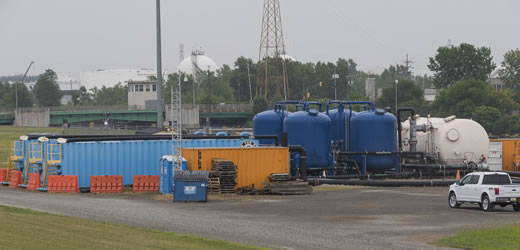Glossary
- activated carbon
- A porous form of carbon with a high surface area available for adsorption of chemicals or chemical reactions.
- area of concern (AOC)
- The U.S.-Canada Great Lakes Water Quality Agreement (Annex 1 of the 2012 Protocol) defines AOCs as “geographic areas designated by the Parties where significant impairment of beneficial uses has occurred as a result of human activities at the local level.” An AOC is a location that has experienced environmental degradation. EPA and other federal and state agencies are working to restore the 27 remaining U.S. AOCs in the Great Lakes basin.
- cancer slope factor (CSF)
- The cancer slope factor is a measure of the incremental lifetime risk of cancer by intake of a chemical. The units of the slope factor are usually expressed as risk per mg/kg-day.
- Clean Air Act
- A law that defines EPA's responsibilities for protecting and improving the nation's air quality and the stratospheric ozone layer.
- Clean Water Act
- A law that establishes the basic structure for regulating discharges of pollutants into the waters of the United States and regulating quality standards for surface waters.
- Confined Disposal Facility (CDF)
-
A facility that was designed to contain existing contaminants onsite and to safely contain contaminated dredged sediments from the Indiana Harbor and Canal.
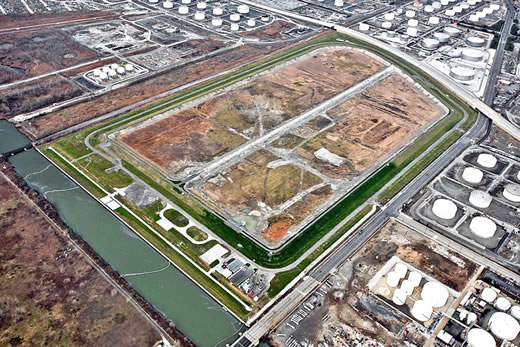
- cubic yard (CY)
- The volume of a cube with sides of 1 yard in length. The volume of sediment that is dredged from the Indiana Harbor and Canal is measured in cubic yards (yd3).
- cutoff wall
-
Underground low permeability clay walls that prevent groundwater from leaving the Confined Disposal Facility (CDF). Also called a slurry wall or slurry cutoff wall.

- dioxins and furans
- The abbreviated name for a family of substances that all share a similar chemical structure. Most dioxins and furans are created as by-products from chemical manufacturing, particularly during herbicide, paper, and pulp production. The USEPA has determined that dioxins and furans are likely carcinogenic, and are known to disrupt hormone systems. Dioxins and furans are mainly distributed through the air, however eating contaminated food is the primary source of exposure for humans. The ambient air monitoring program at the Confined Disposal Facility (CDF) obtains data on the occurrence of dioxins and furans in air samples.
- effluent
- Liquid discharged into a waterway. The treated water effluent at the Confined Disposal Facility (CDF) is discharged into the Lake George branch of the Canal.
- Energy Cooperative, Inc (ECI)
-
A former owner of the property that became the Confined Disposal Facility (CDF). The ECI property was the location of a petroleum products refinery from 1918 to 1981. ECI filed for bankruptcy in 1981.
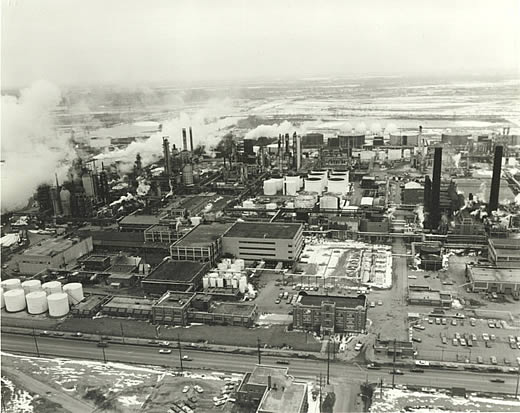
- environmental clam bucket
-
A large bucket used for dredging that has seals to keep dredged material from leaking back into the water. Also known as an environmental bucket, closed bucket, or clamshell bucket. This type of bucket is used for dredging at the Indiana Harbor and Canal.
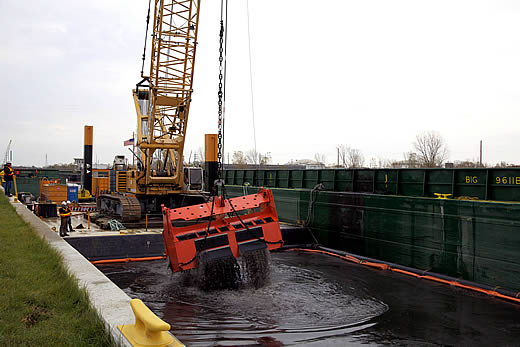
- extraction wells
-
Underground wells that pump groundwater from the area encircled by the cutoff walls of the CDF to the CDF east cell. The groundwater is eventually treated at an onsite water treatment plant and is discharged to the Canal.
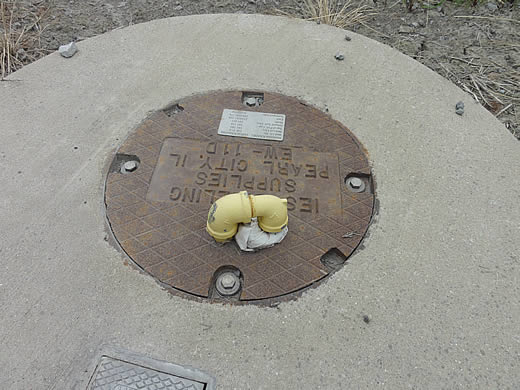
- Gradient Control System (GCS)
-
A custom system that consists of extraction wells and monitoring wells to prevent against offsite migration of groundwater from the Confined Disposal Facility (CDF) site. Also called groundwater control system.
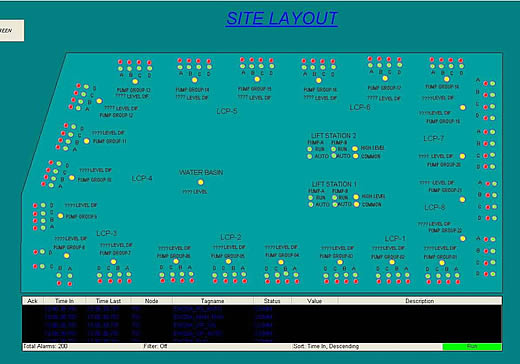
- hazardous air pollutant (HAP)
- Any air pollutant listed by the Administrator of the EPA pursuant to Section 112 of the Clean Air Act, 74 U.S.C. Paragraph 7412.
- hopper barge
-
A hopper barge is a non-mechanical ship or vessel that cannot move around by itself that is designed to carry materials (Wikipedia). Dredged sediment is placed in a hopper barge that is transported via tugboat to the Confined Disposal Facility (CDF).
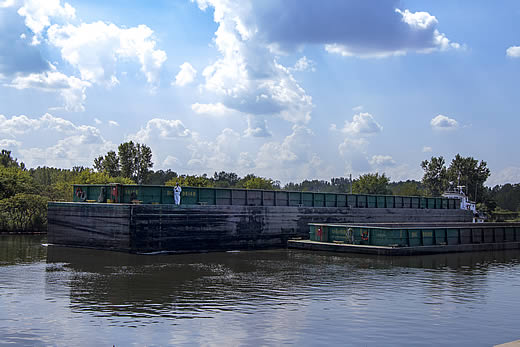
- hybrid ambient particulate monitor
-
An instrument that measures the light scattered by particulates in the air while also collecting particles on a filter and measuring differential reading changes. The hybrid ambient particular monitor at the Confined Disposal Facility (CDF) measures both PM10 and PM2.5 using a hybrid approach.
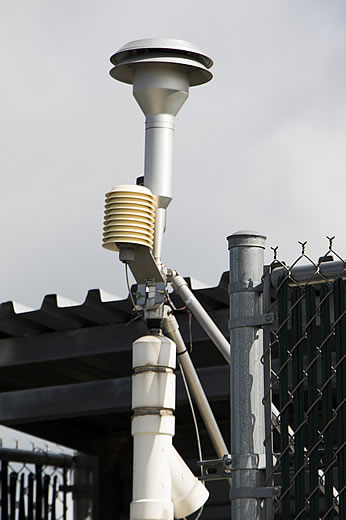
- hydraulic offloading
-
A process used to transfer dredged sediment to the Confined Disposal Facility (CDF). Sediment is mixed with water to form a slurry that is pumped from a hopper barge into the CDF.
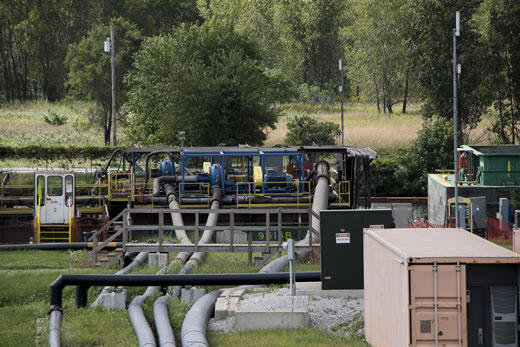
- Indiana Department of Environmental Management (IDEM)
- Implements federal and state regulations to protect human health and the environment while allowing the environmentally sound operations of industrial, agricultural, commercial, and government activities in the state of Indiana. See www.in.gov/idem/. IDEM issued an air registration document which includes emission limits for volatile organic compounds (VOCs) and particulates (PM), and a National Pollution Discharge Elimination System permit which regulates discharges of treated water from the CDF.
- Indiana Department of Natural Resources (IDNR)
- The mission of the Indiana Department of Natural Resources is to protect, enhance, preserve, and wisely use natural, cultural, and recreational resources for the benefit of Indiana's citizens through professional leadership, management, and education. An IDNR Floodway Permit was obtained under IC 14-28-1 with 312 AIC 10 and a Lake Michigan Permit under IC 13-29-1 and 312 IAC 6. These permits were received April 27, 2011 (Applicant FW-26069), and cover dredging in Lake Michigan and in the floodway.
- Indiana Harbor and Canal (IHC)
-
The Indiana Harbor and Canal (IHC) is located on Lake Michigan adjacent to the City of East Chicago, IN. The IHC itself was constructed beginning in 1901 and is maintained by the federal government as authorized by the Rivers and Harbors Act of 1913.
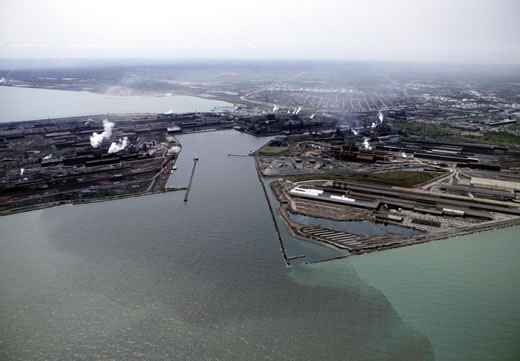
- inward gradient
- The concept of establishing flow into an internal area, thus preventing groundwater from flowing away from the area. The Confined Disposal Facility (CDF) underground slurry walls and Gradient Control System (GCS) maintain an inward gradient to prevent contaminated groundwater from leaving the CDF.
- low permeability
- Permeability is a measure of the ability of a porous material to allow fluids (gas or liquid) to pass through it. Fluids can more easily flow through a material with high permeability than one with low permeability. The cutoff wall that surrounds the Confined Disposal Facility (CDF) is made of low permeability clay to prevent contaminants from leaving the site.
- memorandum of understanding (MOU)
- A formal agreement between two or more parties. To facilitate the CDF project implementation and to ensure that all regulatory issues, including RCRA corrective action and closure, are being covered, the role of the partners is addressed through a Memorandum of Understanding (MOU) between USEPA, IDEM, USACE, and the East Chicago Waterway Management District. As laid out in the MOU, the project coordination includes ongoing engineering evaluation of each project feature by regulatory authorities.
- naphthalene
- An aromatic hydrocarbon that was used historically in significant amounts during petroleum refinery. It is probably best known as the main ingredient of mothballs. Acute (short-term) exposure is associated with liver damage and neurological damage and other effects. Chronic (long-term) exposure has been reported to cause cataracts. The USEPA has classified naphthalene as a Group C, possible human carcinogenic. The real-time air monitoring at the Confined Disposal Facility (CDF) monitors napthalene.
- National Environmental Policy Act (NEPA)
- A law signed on January 1, 1970, that requires federal agencies to assess the environmental effects of their proposed actions prior to making decisions. The water quality monitoring program at Indiana Harbor and Canal provides immediate data to monitor water quality during dredging activities and is consistent with NEPA regulations and guidance.
- National Pollution Discharge Elimination System (NPDES)
- A USEPA permit program that addresses water pollution by regulating point sources that discharge pollutants to waters of the United States. The Confined Disposal Facility (CDF) complies with the “No Exposure Certification for Exclusion from National Pollution Discharge Elimination System (NPDES) Storm Water Permitting” and the terms and conditions of 40 CFR 122.26(g) and the conditions of a NPDES 402 Storm Water Permit. This signifies that all storm water which falls on site will either flow over a clean clay cap which covers the site and into the stormwater ditches, or stormwater will flow into the disposal cells where it will ultimately be treated.
- Nephelometric Turbidity Units (NTU)
- The measure of the amount of light which is scattered due to particles in the water column. These units are equivelant to Formazin Nephelometric Units (FNU).
- No Further Concern
- “No Further Concern” is designated by the USEPA when all individual constituents are at concentrations below a cancer risk level of 1E-06 and a cumulative cancer risk not exceeding 1E-06. Also, all individual constituents are at a concentration below an HQ of 1.0 and a cumulative hazard index for multiple constuents also below 1.0. The hazard quotient for the Action Level 3 is 0.06 at the Confined Disposal Facility.
- off gassing
- The release of a gas that was dissolved, absorbed, or otherwise trapped within a material.
- offsite migration
- The movement of a substance outside of an area. The Confined Disposal Facility (CDF) is designed to prevent offsite migration of groundwater and contaminants outside of the CDF.
- Open-Path Ultra-Violet Differential Optical Absorption Spectrometer (UV-DOAS)
-
An instrument that measures the relationship between the quantity of light absorbed and the number of molecules in the light path. It is a modern technique to monitor trace gas concentrations in the air by analyzing the UV absorption of atmospheric gases. Four UV-DOAS monitors surrounded the perimeter of the Confined Disposal Facility (CDF) from 2012 until 2021 when napthalene monitoring was discontinued.
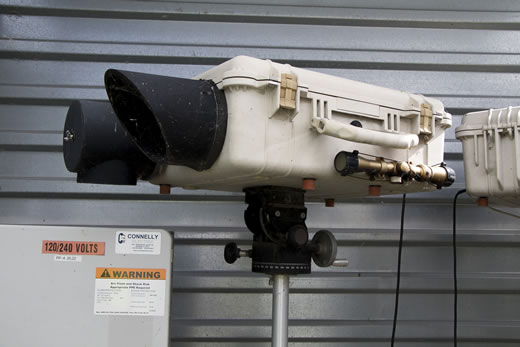
- particulate matter (PM)
- Particulate matter (PM), also called particulates, is the generic term for a broad class of chemically and physically diverse substances that exist as discrete particles (liquid droplets or solids) over a wide range of sizes. Particles originate from a variety of sources and PM can be emitted directly or formed in the atmosphere by gaseous emissions such as sulfur oxides (SOx), nitrogen oxides (NOx), and volatile organic compounds (VOCs). PM has been linked to a range of serious respiratory and cardiovascular health problems. Smaller particles are able to travel long distances, while coarse particles tend to settle out of the atmosphere downwind of the emission.
- parts per million (ppm)
- A unit of measurement used to identify quantities of volatile organic chemicals (VOCs) in the air.
- photoionization detector (PID)
-
An instrument that measures volatile organic compounds (VOCs) and other gases. PID monitoring takes place daily near the Confined Disposal Facility (CDF) dock prior-to and during dredging. PID monitoring at the dock area provides data on the effects of sediment activity at the barge on emission levels for worker and community safety.
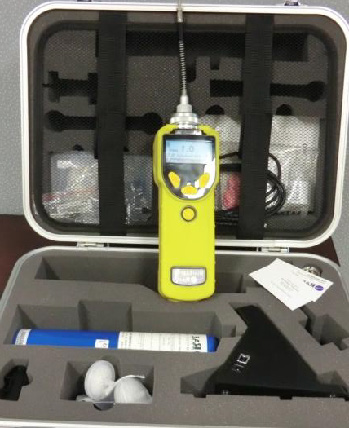
- PM10 and PM2.5
- Widely monitored air pollutants. PM2.5 refers to fine particles with aerodynamic diameters of less than or equal to 2.5 micrometers, while PM10 refers to coarse particles with aerodynamic diameters of less than 10 micrometers (including PM2.5). PM2.5 tends to form as atmospheric transformation products and from organic compounds. PM10 is typically the resuspension of industrial dust, disturbed soil, construction, coal and oil combustion, or biological sources.
- polychlorinated biphenyl (PCB)
- A mixture of synthetic organic chemicals with the same basic chemical structure and similar physical properties ranging from oily liquids to waxy solids that are colorless to light yellow. Certain PCBs are carcinogenic, toxic, and replicate human hormones. PCBs have no known smell or taste. Due to their non-flammability, chemical stability, high boiling point, and electrical insulating properties, PCBs were used in hundreds of industrial and commercial applications including electrical, heat transfer, and hydraulic equipment; as plasticizers in paints, plastics and rubber products; in pigments, dyes and carbonless copy paper and many other applications. More than 1.5 billion pounds of PCBs were manufactured in the United States prior to cessation of production in 1977.
- polycyclic aromatic hydrocarbons (PAHs)
- A group of over 100 different chemicals that are formed during the incomplete burning of coal, oil and gas, garbage, or other organic substances like tobacco or charbroiled meat. PAHs are usually found as a mixture containing two or more of these compounds, such as soot. Some PAHs are manufactured. These pure PAHs usually exist as colorless, white, or pale yellow-green solids. PAHs are found in coal tar, crude oil, creosote, and roofing tar, but a few are used in medicines or to make dyes, plastics, and pesticides.
- Resource Conservation and Recovery Act (RCRA)
- A public law that creates the framework for the proper management of hazardous and non-hazardous solid waste. The law describes the waste management program mandated by Congress that gave EPA authority to develop the RCRA program. The term RCRA is often used interchangeably to refer to the law, regulations and EPA policy and guidance. Both the Indiana Department of Environmental Management (IDEM) and the U.S. Environmental Protection Agency (USEPA) have determined that RCRA closure will be required on the Confined Disposal Facility (CDF) site due to soil and groundwater contamination, and thus will be subject to post-closure permitting requirements.
- revetment
-
Walls or sloping structures placed on banks or cliffs to absorb the energy of incoming water. The south cutoff wall at the Confined Disposal Facility (CDF) is a revetment.
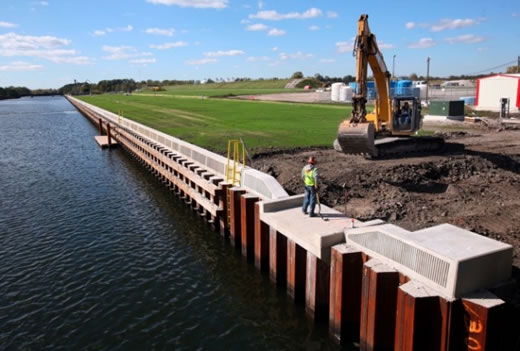
- slurry
-
A liquid mixture of solids and water. To transport sediment to the Confined Disposal Facility (CDF), the dredged sediment is mixed with water to form a slurry that is then pumped into the CDF.
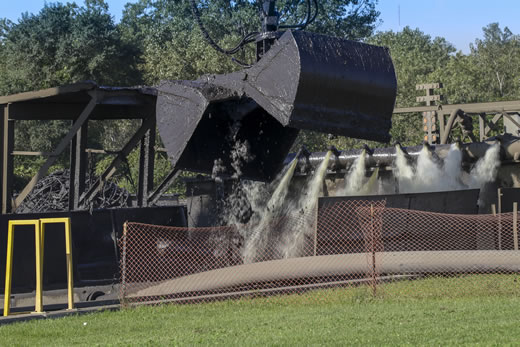
- total suspended particulates (TSP)
- A measure of the mass concentration of particulate matter (PM) in the air regardless of particle size.
- total suspended solids (TSS)
- Measures the amount of suspended particles between the sediment and the surface of the water (water column). Suspended solids include silt and clay particles, plankton, algae, fine organic debris, and other particulate matter. Suspended solids may carry toxic chemicals and can negatively affect aquatic organisms, water temperature, and dissolved oxygen levels.
- Toxic Substances Control Act (TSCA)
- Provides EPA with authority to require reporting, record-keeping and testing requirements, and restrictions relating to chemical substances and/or mixtures. A portion of the polluted sediments from the Indiana Harbor and Canal are regulated by the TCSA.
- U.S. Army Corps of Engineers (USACE)
- The U.S. Army Corps of Engineers (USACE) delivers public and military engineering services; partnering to strengthen the Nation’s security, energize the economy and reduce risks from disasters. The USACE Chicago District is responsible for water resources development in the Chicago metropolitan area. The Chicago District is involved in a variety of projects stemming from its primary mission areas of flood control, shoreline protection, navigation, environmental protection, emergency management, and support for others. From storm and flood damage reduction to maintaining safe navigation, the Chicago District is committed to providing quality, cost-effective, and environmentally sustainable planning, engineering, and construction products and services.
- U.S. Environmental Protection Agency (USEPA)
- Established to consolidate in one agency a variety of federal research, monitoring, standard-setting, and enforcement activities to ensure environmental protection. The Indiana Harbor and Canal Dredging Project maintains air and water quality monitoring programs to demonstrate that impacts from the project area are consistent with USEPA guidance. Also known as EPA.
- United States Geological Survey (USGS)
- The U.S. Geological Survey (USGS) is a science organization that provides impartial information on the health of our ecosystems and environment, the natural hazards that threaten us, the natural resources we rely on, the impacts of climate and land-use change, and the core science systems that help us provide timely, relevant, and useable information. Air monitoring is being performed near East Chicago Central High School by the USGS to continuously measure air quality near the high school to avoid negative environmental impacts to the surrounding community from dredging and sediment disposal activities.
- volatile organic compounds (VOCs)
- Organic chemicals that easily vaporize at room temperature. They are called organic because they contain the element carbon in their molecular structures. VOCs are found in everything from paints and coatings to underarm deodorant and cleaning fluids. As a product of incomplete combustion, VOCs are found in automobile exhaust. They also come from the evaporation of fuels and solvents, and from industrial processes. They are a major concern of the USEPA and state air quality boards all over the United States. VOCs have been found to be a major contributing factor to ozone, a common air pollutant which has been proven to be a public health hazard. In addition to ozone (smog) effects, many VOCs can cause serious health problems such as cancer and other effects.
- water treatment plant
-
A facility that improves the quality of water to make it suitable for an intended use. The Confined Disposal Facility (CDF) has an onsite water treatment plant that treats CDF water to levels that are suitable for discharge into the Canal.
